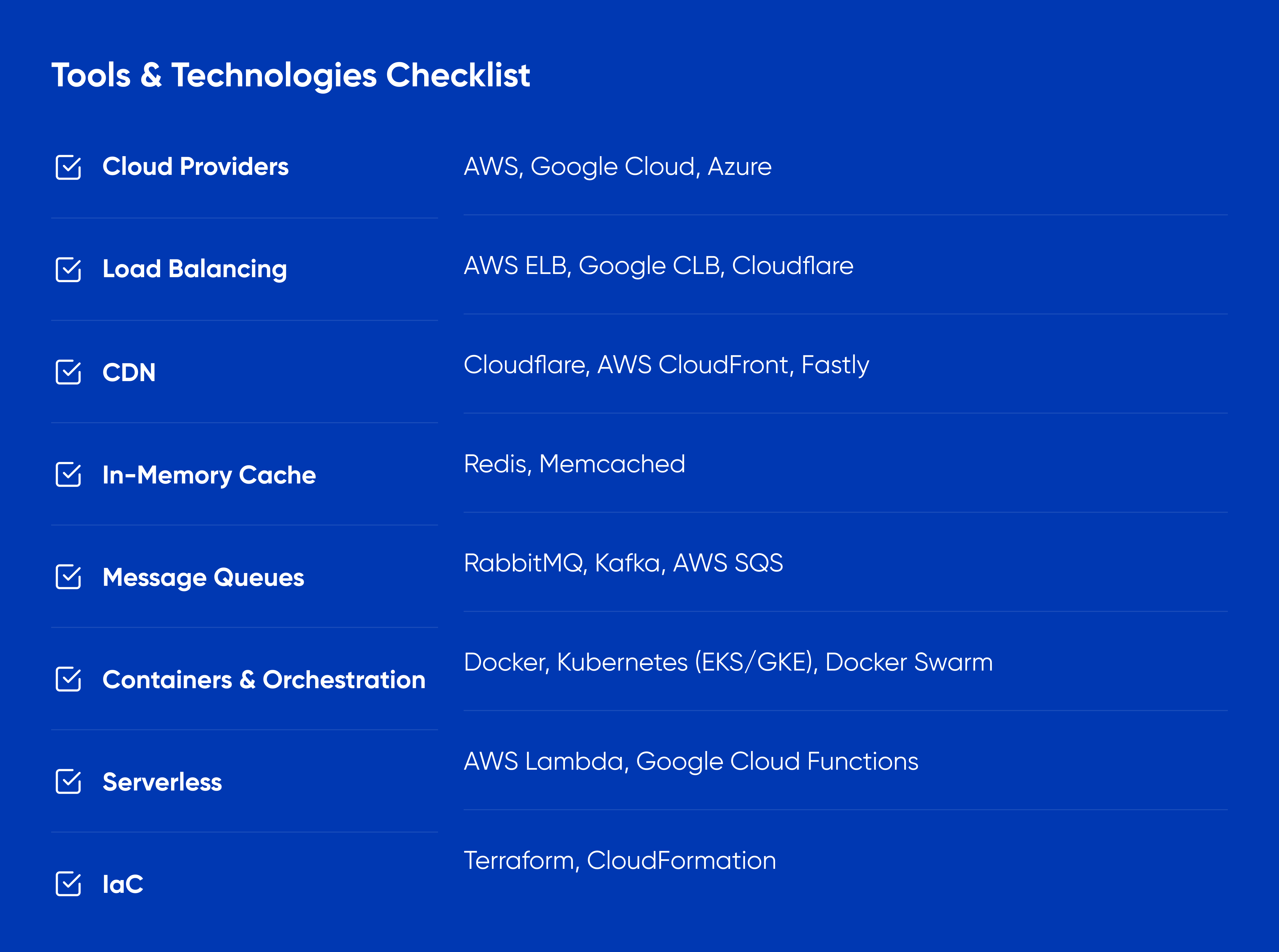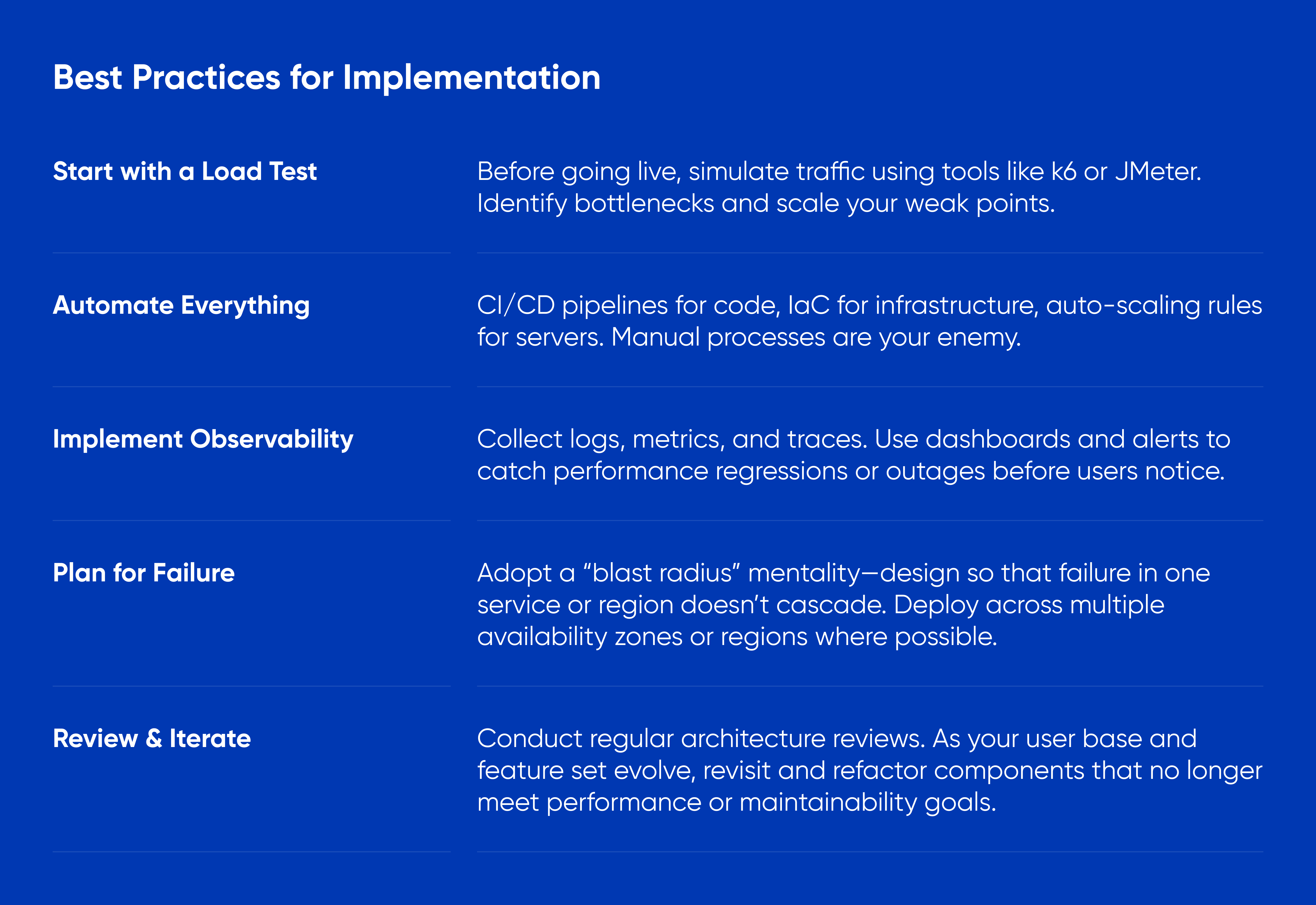Growing fast is every startup’s dream—but if your infrastructure can’t keep up, you risk slowdowns or outages that cost users and revenue. Designing a scalable web architecture from day one helps you absorb traffic spikes, ship new features safely, and focus on innovation rather than firefighting. In this guide, we’ll cover the core principles, patterns, and tools that product owners, CTOs, and founders need to build resilient, high-performing web platforms.
Why Scalability Matters for Startups
-
Handle Sudden Traffic Spikes: A feature mention on TechCrunch or a viral tweet can send thousands of visitors to your site in minutes. Without auto-scaling, your servers could crash under load.
-
Maintain Fast Load Times: As your user base grows, unoptimized systems lead to slower page loads and frustrated customers—resulting in higher bounce rates and lower conversions.
-
Enable Rapid Feature Releases: A modular, scalable back end lets development teams deploy updates without risking system-wide outages. Continuous delivery becomes a reality, not a dream.
-
Optimize Costs: Elastic infrastructure lets you pay only for what you use. Scale up during peak demand and scale down during quiet periods to control cloud bills.
Core Principles of Scalable Architecture
1. Stateless Services & Horizontal Scaling
-
Statelessness: Design services so that no critical data is stored locally on a single server. Store sessions and user data in a distributed cache (e.g., Redis) or a shared database.
-
Horizontal Scaling: Add more server instances rather than beefing up a single machine. Load balancers distribute requests evenly, ensuring no single node is overwhelmed.
2. Managed Load Balancing
-
Use cloud-based load balancers (AWS ELB, Google Cloud Load Balancing) to automatically route traffic across healthy instances.
-
Implement health checks so unhealthy servers are removed from rotation until they recover.
3. Caching Strategies
-
Edge Caching: Leverage a CDN (Cloudflare, AWS CloudFront) to serve static assets (images, CSS, JS) from servers near your users—reducing latency and offloading your origin servers.
-
Application Caching: Cache frequent database queries in-memory (Redis or Memcached) to reduce database load and speed up response times.
4. Decoupling & Asynchronous Processing
-
Message Queues: Use systems like RabbitMQ, Apache Kafka, or AWS SQS to decouple services. For example, when a user signs up, you can place a “send welcome email” task into a queue instead of processing it during the HTTP request.
-
Worker Processes: Spin up background workers that consume queue messages, allowing your web servers to stay light and responsive.
5. Database Scalability
-
Read Replicas: Offload read-heavy workloads to replica databases. Writes still go to the master, but reads can be distributed.
-
Sharding & Partitioning: Split large tables by key (customer ID, geographic region) to spread load across multiple database instances.
6. Infrastructure as Code (IaC)
- Define your entire infrastructure in code (Terraform, AWS CloudFormation). This ensures identical environments from staging to production and enables version control for your infrastructure changes.
Scalable Architecture Patterns
Monolithic → Modular Monolith
-
Start Simple: Launch with a well-structured monolith. Keep code modular—group related features into modules or components.
-
Evolve Gradually: As the codebase and team grow, extract performance-critical or independently deployable components into services.
Microservices Architecture
-
Service Boundaries: Split functionality by domain (e.g., authentication, payments, notifications).
-
Independent Deployment: Each service has its own repo, CI/CD pipeline, and scaling rules.
-
API Gateways: Use an API gateway (e.g., Kong, AWS API Gateway) to route requests to the appropriate microservices and handle cross-cutting concerns (rate limiting, authentication).
Serverless Functions
-
Event-Driven: Offload episodic workloads—image processing, data transformations, or real-time notifications—to serverless functions (AWS Lambda, Google Cloud Functions).
-
Zero Maintenance: No servers to manage; functions scale automatically and you pay only for execution time.
Containerization & Orchestration
-
Docker Containers: Package services and dependencies into containers for consistent deployments.
-
Kubernetes: Orchestrate containers at scale, automating rollouts, rollbacks, and self-healing. Managed services (EKS, GKE, AKS) remove much of the operational overhead.
Tools & Technologies Checklist

Best Practices for Implementation

Real-World Startup Success Stories
-
Netflix: Transitioned from a monolith to microservices, leveraging AWS to handle billions of events daily. Their architecture includes hundreds of microservices and an advanced chaos engineering practice to ensure resilience.
-
Airbnb: Uses a service-oriented architecture with shared caching layers and a robust CDN network to serve millions of listing images. Their emphasis on careful data partitioning and read-replica strategies has kept performance high during peak booking seasons.
-
Slack: Powered by a combination of a modular monolith and serverless functions for non-critical tasks (like analytics aggregation), Slack ensures rapid deployment cycles and reliable messaging at scale.
Next Steps for Your Startup
-
Assess Current State: Map out your existing architecture, noting single points of failure and performance constraints.
-
Define Growth Targets: Estimate traffic and data volumes for the next 6–12 months. Use these projections to design scaling rules.
-
Prototype Slowly: Move one component at a time—add caching first, then introduce a message queue, then extract a microservice.
-
Measure & Learn: After each change, benchmark performance and costs. Adjust your approach based on real data.
Designing scalable web architectures might seem daunting, but with a clear roadmap and the right tools, your startup can handle rapid growth without sacrificing performance or team velocity.
Ready to scale your infrastructure for the next million users? Movadex’s expert engineers specialize in cloud-native, microservices, and serverless architectures tailored to fast-moving startups. Contact us today and let’s build a platform that grows with you.




